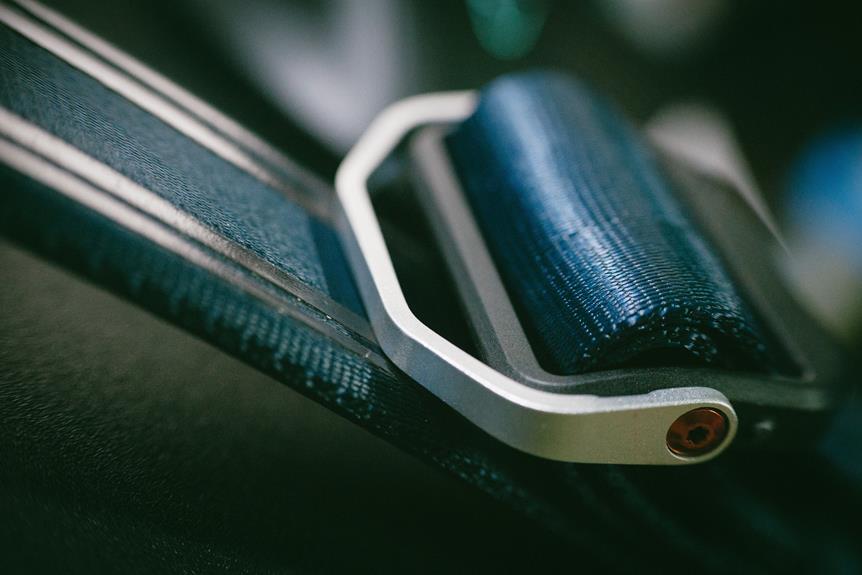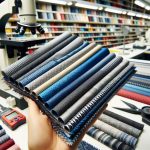Looking for the right nylon strapping for your project? It's essential to consider a few key factors to ensure the best fit.
Understanding the properties of nylon strapping, assessing weight capacity and tensile strength, evaluating durability and resistance to environmental factors, and considering width and thickness for application suitability are all crucial aspects.
Additionally, exploring different weave patterns and texture, factoring in UV resistance and color options, and analyzing cost-effectiveness and long-term value will help you make an informed decision.
With these considerations in mind, you'll be well-equipped to choose the best nylon strapping for your specific project needs.
Key Takeaways
- Consider the weight capacity and tensile strength of nylon strapping when choosing the most suitable option for your project.
- Evaluate the durability and resistance to environmental factors such as UV radiation, moisture, and extreme temperatures to ensure the strapping can withstand wear and tear over time.
- Take into account the width and thickness of the strapping to determine its load-bearing capacity and flexibility.
- Explore different weave patterns and textures of nylon strapping to find the one that best suits your specific needs, whether it is for general-purpose use or heavy-duty applications.
Understanding Nylon Strapping Properties
When selecting nylon strapping for your project, it's important to understand its properties to ensure optimal performance.
Nylon strapping is known for its exceptional elasticity, allowing it to stretch without losing its shape or strength. This property is crucial for applications where the strapping needs to secure and support items without breaking or becoming loose.
Additionally, nylon strapping exhibits impressive heat resistance, making it suitable for use in high-temperature environments without compromising its integrity.
Tear strength is another important property of nylon strapping. This material can withstand significant force without tearing, making it reliable for heavy-duty applications. Whether you're securing large cargo or creating a durable strap for industrial use, nylon strapping's tear strength is a valuable characteristic to consider.
Furthermore, chemical resistance is a key feature of nylon strapping, as it can withstand exposure to various chemicals without deteriorating. This makes it suitable for applications where contact with chemicals is likely.
Understanding these properties of nylon strapping will enable you to make an informed decision when choosing the best strapping for your project.
Assessing Weight Capacity and Tensile Strength
To assess the weight capacity and tensile strength of nylon strapping for your project, consider the maximum load it can support and the force it can withstand without breaking. When assessing elasticity, it's crucial to compare different brands to find the one that best suits your needs.
Weight capacity refers to the maximum load the strapping can support without failing, while tensile strength measures the force the strapping can withstand before breaking. These factors are essential in determining the suitability of nylon strapping for your specific project. When comparing brands, look for information on weight capacity and tensile strength in the product specifications.
Keep in mind that the weight capacity and tensile strength requirements may vary depending on the nature of your project. By carefully assessing these factors and comparing different brands, you can ensure that the nylon strapping you choose will effectively meet the weight-bearing and strength demands of your project.
Evaluating Durability and Resistance to Environmental Factors
Assess the durability and resistance of nylon strapping to environmental factors to ensure its suitability for your project. When evaluating the durability of nylon strapping, consider its ability to withstand wear and tear over time. Look for strapping that has high tensile strength and is resistant to abrasion, as these are indicators of durability. Additionally, assess the strapping's ability to maintain its integrity in various environmental conditions, such as exposure to UV radiation, moisture, and extreme temperatures.
When evaluating the resistance of nylon strapping to environmental factors, consider the following:
- UV Resistance: Look for nylon strapping that's UV resistant to prevent degradation and weakening when exposed to sunlight for extended periods.
- Check for UV protection additives that can enhance the strapping's resistance to UV radiation.
- Moisture Resistance: Choose nylon strapping that's resistant to moisture to prevent mold, mildew, and weakening when exposed to damp or wet conditions.
- Look for strapping with moisture-resistant coatings or treatments to enhance its longevity in humid environments.
Assessing the durability and environmental resistance of nylon strapping is crucial for selecting a reliable and long-lasting solution for your project.
Considering Width and Thickness for Application Suitability
To ensure the suitability of the nylon strapping for your project, consider the appropriate width and thickness that will best meet the demands of your application.
When selecting nylon strapping, it's crucial to carefully evaluate the width and thickness in relation to the specific requirements of your project. The width of the strapping is vital as it directly impacts the overall strength and load-bearing capacity. A wider strapping provides better load distribution, making it suitable for heavy-duty applications. On the other hand, thinner strapping may be more appropriate for lighter loads or where flexibility is a key concern.
In addition to width, the thickness of the nylon strapping is equally important. Thicker strapping offers increased strength and durability, making it ideal for applications that involve higher stress or tension. However, thinner strapping can be more flexible and easier to manipulate, which may be advantageous in certain scenarios.
When considering width and thickness, it's essential to also take into account material compatibility, color options, and weather resistance to ensure that the chosen nylon strapping aligns with the specific demands of your project. By carefully evaluating these factors, you can select nylon strapping that's best suited for your application.
Exploring Different Weave Patterns and Texture
When selecting nylon strapping, consider the various weave patterns and textures available to determine the most suitable option for your project. Weave patterns and material texture play a crucial role in the performance and durability of nylon strapping. Here are some key points to consider:
- Weave Patterns
- Plain Weave: Offers a balanced construction and is suitable for general-purpose strapping.
- Twill Weave: Provides a diagonal rib pattern, offering increased strength and durability for heavy-duty applications.
- Texture Variations
- Smooth Texture: Ideal for applications where minimal friction is desired, such as with delicate cargo or when the strapping comes into direct contact with objects.
- Ribbed Texture: Offers enhanced grip and friction, making it suitable for applications where a secure hold is essential, such as in heavy-duty bundling or securing items during transport.
Understanding the available pattern options and texture variations will allow you to select nylon strapping that best aligns with the specific requirements of your project. By considering these factors, you can ensure that the chosen strapping will deliver the performance and reliability needed for your application.
Factoring in UV Resistance and Color Options
Consider the various UV-resistant and color options available when selecting nylon strapping for your project to ensure optimal performance and longevity.
When choosing nylon strapping, it's important to consider the level of UV resistance needed for your specific application. UV resistance is crucial for outdoor use, as prolonged exposure to sunlight can cause regular nylon strapping to degrade and become brittle over time. Opting for UV-resistant nylon strapping ensures that it can withstand the damaging effects of the sun, providing durability and reliability.
In addition to UV resistance, color options are also an important factor to consider. Whether you need high-visibility colors for safety purposes or want to match the strapping to your company colors for branding, selecting the right color can enhance both functionality and aesthetics.
To help you make an informed decision, here's a table summarizing the UV resistance and color options available for nylon strapping:
| UV Resistance | Color Options |
|---|---|
| High | Red |
| Medium | Blue |
| Low | Yellow |
Understanding the UV resistance and color options will allow you to choose nylon strapping that not only meets your functional needs but also aligns with your project's visual requirements.
Cost-Effectiveness and Long-Term Value Analysis
When it comes to choosing nylon strapping, you want to weigh the cost against the durability it provides.
It's important to consider the long-term investment and compare the value for money of different options.
This analysis will help you make a well-informed decision that aligns with your project's needs and budget.
Cost Vs. Durability
To determine the best nylon strapping for your project, assess the cost-effectiveness and long-term value of different options. When considering cost versus durability, it's essential to conduct a thorough cost analysis and evaluate the material longevity. Here are some key points to keep in mind:
- Cost Analysis:
- Consider the initial cost of the nylon strapping as well as any additional expenses such as installation or maintenance.
- Evaluate the potential cost savings over time by choosing a durable nylon strapping that requires minimal replacement or repairs.
Long-Term Investment Comparison
Assess the long-term cost-effectiveness and value of different nylon strapping options for your project to make an informed decision.
When considering the investment comparison, it's essential to weigh the upfront cost of the nylon strapping against its material longevity.
While some options may have a lower initial price, they might wear out more quickly, leading to the need for frequent replacements.
On the other hand, higher-quality nylon strapping may require a larger upfront investment but offer greater durability, reducing the need for replacements and maintenance in the long run.
Value for Money
Consider the initial cost and long-term durability of different nylon strapping options to determine their value for money. When evaluating the value for money of nylon strapping, it's essential to weigh the initial cost against its long-term durability. Here are some factors to consider:
- Cost Effectiveness:
- Look for budget-friendly options that offer high tensile strength and abrasion resistance.
- Evaluate the cost per foot or meter of strapping to compare different options.
Frequently Asked Questions
Can Nylon Strapping Be Used for Underwater Applications?
Yes, nylon strapping can be used for underwater applications. It offers excellent material compatibility, strength, and durability. Additionally, it has good corrosion resistance and minimal environmental impact, making it a reliable choice for underwater projects.
Are There Any Special Considerations for Using Nylon Strapping in Extreme Temperatures?
When using nylon strapping in extreme temperatures, it's crucial to consider material compatibility and long-term durability. Temperature fluctuations can impact the performance, so ensure the strapping is designed for the specific temperature range.
What Are the Best Practices for Storing and Maintaining Nylon Strapping?
To store and maintain nylon strapping, keep it in a cool, dry place away from direct sunlight and extreme temperatures. Regularly inspect for wear and tear, and conduct durability testing to ensure it meets your project's requirements.
Can Nylon Strapping Be Easily Cut to Custom Lengths for Specific Projects?
You can easily custom cut nylon strapping to specific lengths for your projects. Its versatility, strength, and durability make it a great choice. This feature allows you to tailor the strapping to your exact needs.
Are There Any Specific Safety Guidelines for Using Nylon Strapping in Industrial or Heavy-Duty Applications?
When using nylon strapping in industrial or heavy-duty applications, it's crucial to adhere to specific safety regulations and ensure material compatibility. Always check the manufacturer's guidelines and choose strapping that meets the necessary safety standards.
- What Is the Dip Dye Technique? a Simple Fabric Dyeing Method - July 13, 2025
- The Ultimate Guide to Ice Dyeing Techniques - July 13, 2025
- How Does Ice Dyeing Look Different From Traditional Tie-Dye? - July 13, 2025







